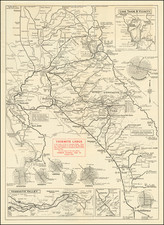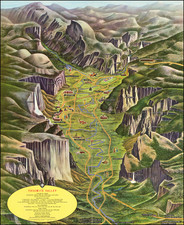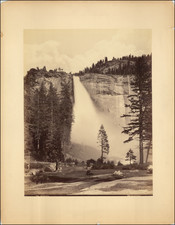Mammoth Plate Photograph by Watkins
"Carleton E. Watkins was a giant of photography. He is arguably America's greatest landscape photographer" - Palmquist & Kailbourn
A beautiful mammoth-plate photograph of Nevada Fall, Yosemite, by the great western photographer Carleton Watkins. This print was issued by Isaiah Taber soon after his 1881 acquisition of Watkins's negatives.
In 1861 Watkins began making his famous large-scale "mammoth-plate" photographs in California's Yosemite Valley -- iconic views that are now unanimously accepted as some of the most beautiful photographic images ever made in the West. These images were influential in persuading the United States Congress to pass pioneering legislation to preserve Yosemite Valley, which bill, the Yosemite Valley Grant Act, was signed into law by Abraham Lincoln on June 30, 1864. This law granted Yosemite Valley and the Mariposa Grove to the State of California, "to be held for public use, resort, and recreation...[the use of which in this manner] shall be inalienable for all time." Watkins was consulted by Yosemite Commissioner Frederick Law Olmsted on the best means to preserve Yosemite as a public trust. It wasn't until 1890, through the efforts of John Muir and others, that Yosemite was signed into existence as the nation's third National Park.
While the technical and aesthetic qualities of Watkins's Yosemite photographs were early lauded by enthusiasts and experts alike, including William H. Brewer of the California State Geological Survey ("the finest I have seen"), J. D. Whitney (who named a 8,500-foot peak in Yosemite after Watkins), Edward L. Wilson (editor of the Philadelphia Photographer, who noted that "[Watkins's] camera is mightier than the sword") and Oliver Wendell Holmes (the foremost photography critic of the time who said Watkins's photographs reached "a perfection of art which compares with the finest European work"), it wasn't until the 1970s that Watkins was re-discovered by the photographic art world, thus shining a brighter light on his life and work. Watkins's mammoth-plate views of Yosemite are now solidly ensconced as part of the canon of fine art photography. Examples of Watkins's Yosemite photographs are in many great institutional collections, including those in the Bancroft Library, the Getty, the Metropolitan Museum of Art, the Huntington Library, and numerous other institutions.
Mammoth-plate Camera
Watkins made the negative for this image using his custom made oversized camera. This camera was constructed by a local San Francisco instrument maker to handle negatives as large as 18 x 22 inches (the so-called mammoth-plate format).
Watkins's most famous visit to Yosemite Valley took place in the summer of 1861, when the photographer brought with him for the first time a special camera designed to accommodate sheets of glass 45.7 x 55.9 cm (18 x 22 inches) in size that were popularly called "mammoth plates." Exactly how Watkins procured this highly unusual oversize camera is uncertain. One possibility is that it was fabricated by someone such as Thomas Tennant, who advertised his services in Hutchings's magazine as an instrument maker on Battery Street in San Francisco. - Naef & Hult-Lewis, page 45.
Isaiah W. Taber
In the fall of 1875 financial problems led to Watkins's creditor calling in loans, resulting in the ownership of Watkins's negatives passing to one John Jay Cook, a little-known Mariposa County businessman. Cook then partnered with the San Francisco photographer Isaiah W. Taber to market Watkins's work.
Taber instructed his staff to occasionally modify Watkins's negatives by adding clouds into Watkins's skies. In printing his own work Watkins had long resisted this practice, but it was fairly common among landscape photographers at the time due to limitations of 19th century photographic chemicals. The present photograph may have received this treatment, yet to modern eyes the overall effect actually appears natural.
Title and credit to Taber appears in the lower margin, in the negative.
The late number (790) in the caption -- but not too late.
In their study of Watkins's mammoth photographs Naef & Hult-Lewis suggest mammoth plate prints under Taber's name numbered above 717 (but under 900) can be attributed to Watkins. The photographer's own numbering system was somewhat idiosyncratic and did not follow a chronological sequence. Thus, it is hard to pin down a definite date for the present image.
... a handful of Taber/Watkins prints bearing numbers 677 and above cannot be directly matched to any print made by Watkins when he had possession of the negatives. ... Taber also issued prints under his name from mammoth-plate negatives bearing numbers above 717 (the highest known Watkins negative number in his Old Series)....Watkins had demonstrated the pattern in Yosemite and elsewhere of returning to the same subject to photograph it a second or even third time to improve the composition... Mammoth-plate prints over Taber's name that are numbered 900 and above are by an as-yet-unidentified photographer who was active in the late 1880s and early 1890s.
An iconic photograph of a quintessential Yosemite view by one of the greatest of western photographers.
Carleton Watkins (American, 1829-1916) was one of the most highly acclaimed of early western photographers, yet Watkins's work has never been fully cataloged. No complete listings of his "Old Series" stereoviews, published before 1875, are known.
Watkins extensively photographed early San Francisco, Yosemite, Mendocino and the Sierra Nevada mining regions. His photogaphs of Yosemite helped influence Congress and President Lincoln in the preservation of Yosemite Valley. Watkins also made some of the earliest photographs of Southern California and the Pacific Nortwest. Watkins' Pacific Railroad series documents construction of the trans-continental railroad from Sacramento to Utah.











![California and Nevada [Yosemite, Sacramento, and San Francisco Insets]](https://storage.googleapis.com/raremaps/img/small/79443.jpg)
![(Mammoth Plate Photograph) [View on the Merced, Yosemite]](https://storage.googleapis.com/raremaps/img/small/88250.jpg)

